

Giving Voice to the Nation: The Arts Council of Great Britain and the Development of Theatre and Performance in Britain 1945-1995 - University of Reading. Description of the project Arts Council of Great Britain Archives Publications from the project Description of the project Public subsidy is the cornerstone of post-war British theatre: new writing; new theatre spaces; new theatrical styles and genres; the birth of the fringe and the encouragement of ethnic minority involvement all owe their continuing existence to the policies and financial backing of Arts Council of Great Britain (ACGB).
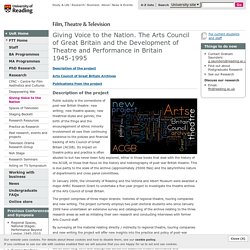
Its impact on theatre policy and practice is often alluded to but has never been fully explored, either in those books that deal with the history of the ACGB, or those that focus on the history and historiography of post-war British theatre. In January 2009, the University of Reading and the Victoria and Albert Museum were awarded a major AHRC Research Grant to undertake a five-year project to investigate the theatre archive of the Arts Council of Great Britain. For more information, please contact g.saunders@reading.ac.uk. Why every artist should be a community artist. Last week’s Devoted and Disgruntled (D&D)/In Battalions event discussing how the theatre industry should engage with the current Tory government was a lively affair.
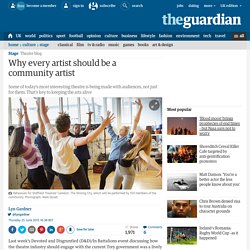
There were plenty of good ideas, from the suggestion that there should be another In Battalions report to reminders that we need long-term thinking about a coherent arts policy extending 20 years or more, and ideas around working collectively and changing the language of arts funding. (Which might mean not using the words arts and funding in the same sentence). Of course it’s important to keep engaging with any government and potential future governments, and not just when there’s an election or comprehensive spending review looming. It’s far too late to wheel out somebody called Nick or Rufus or David or Daniel when crisis is imminent. There are already useful lobbying organisations such as What Next? But getting the public to lobby for the arts means a far more generous and transparent approach. Interview. Essays. On Maidan and Imaginary Archive Kyiv, Spring 2014 (2014) 50 Shades of Red: Enterprise Culture and Social Practice Art, a Love Story?
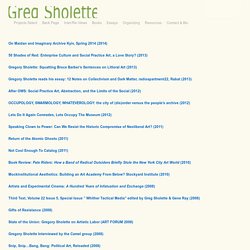
(2013) Gregory Sholette: Squatting Bruce Barber’s Sentences on Littoral Art (2013) Gregory Sholette reads his essay: 12 Notes on Collectivism and Dark Matter, radioapartment22, Rabat (2013) Belfast Exposed Blog. Friday 23 August at BX Pauline, Ciara, Mervyn for BX and Patrick Fox (Create), Fergus Jordan (BX Engagement Team), Anthony Luvera and Eugenie Dolberg (artists), Menkia van der Poorten and Ruth Moore (arts development, researchers and note takers) The questions Why do groups want to get involved in photography and with BX?
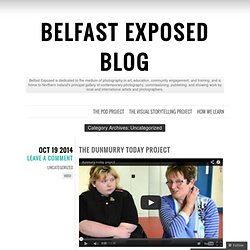
Why do artists want to work with communities? Is there a difference between what managers, leaders and rank and file participants want from projects? Q.1 Why would groups want to get involved/ why would artists want to get involved? Patrick Fox (PF) In asking what does the community want, we need to consider what we mean by community? Why photography? Eugenie Dolberg (ED) The Pilot Project under development. What is it? Pauline Hadaway (PH) It is a tentative stage. On the other hand, it may not lead anywhere in terms of an artistic output or production. Anthony Luvera (AL) We don’t know where it will lead. Archive Live. Our Museum. Communities - Belfast Exposed - Photography Exhibitions, Training, Photography Courses and Image Archive in Belfast, Northern Ireland. Photograph taken by a student on one of our photography courses Belfast Exposed has over 20 years' experience delivering photographic projects with local communities across Northern Ireland.
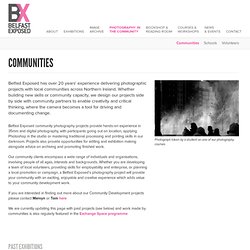
Whether building new skills or community capacity, we design our projects side by side with community partners to enable creativity and critical thinking, where the camera becomes a tool for driving and documenting change. Photography in the Community Policy - Policies - Belfast Exposed - Photography Exhibitions, Training, Photography Courses and Image Archive in Belfast, Northern Ireland. Thirty years ago, a small team of local photographers initiated an exhibition of amateur photography reflecting the experience of Belfast from the inside.
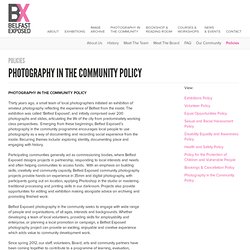
The exhibition was called 'Belfast Exposed', and initially comprised over 200 photographs and slides, articulating the life of the city from predominately working class perspectives. Emerging from these beginnings, Belfast Exposed’s photography in the community programme encourages local people to use photography as a way of documenting and recording social experience from the inside.
Recurring themes include: exploring identity, documenting place and engaging with history. Participating communities generally act as commissioning bodies, where Belfast Exposed designs projects in partnership, responding to local interests and needs and often helping communities to access funds. Birmingham Black Oral History Project. We know that these clips mostly focus on the negative aspects of black people's lives in Birmingham - but that's what interested the TV companies. 1960s Interviews about Smethwick Corporation's plan to buy up houses in Marshall Street and rent them to white tenants only, 1964 Malcolm X visits Smethwick, 1965 (no sound) Interview with the wife of a Smethwick Councillor who has fostered a black baby, 1965 Report on protests by local residents in Rowley Regis after a black family buys a house on the same estate, 1965.

The Citizen Artist: 20 Years of Art in the Public Interest. The Citizen Artist: 20 Years of Art in the Public Arena An Anthology from High Performance Magazine 1978-1998 Edited by API codirectors Linda Frye Burnham and Steven Durland Published in May 1998 by Critical Press for their series: Thinking Publically: The New Era of Public Art INTRODUCTION Art FOR the public?
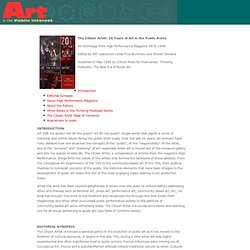
About High Performance magazine. About High Performance High Performance was a quarterly arts magazine founded in 1978 and published until 1997.
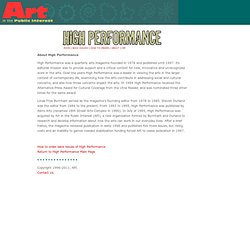
Its editorial mission was to provide support and a critical context for new, innovative and unrecognized work in the arts. Over the years High Performance was a leader in viewing the arts in the larger context of contemporary life, examining how the arts contribute in addressing social and cultural concerns, and also how those concerns impact the arts. In 1994 High Performance received the Alternative Press Award for Cultural Coverage from the Utne Reader, and was nominated three other times for the same award.
Linda Frye Burnham served as the magazine's founding editor from 1978 to 1985. How to order back issues of High Performance Return to High Performance Main Page. Art in the Public Interest. Community-based Art for Social Change. By Kathie deNobriga and Mat Schwarzman Community-based art is creative expression that emerges from communities of people working together to improve their individual and collective circumstances.

Community-based art involves a wide range of social contexts and definitions, and includes an understanding of “communities” that includes not only geographical places, but also groups of people identified with historical or ethnic traditions, or dedicated to a particular belief or spirit. Those who identify themselves as community-based artists are concerned with the ways art can function within many different types of public arenas, including community development, corrections, education, intergenerational communication, aging, the environment, healthcare, technology, politics, disability, conflict resolution, community regeneration, cultural citizenship and more.
They are working in all media, in all disciplines, in all locations.